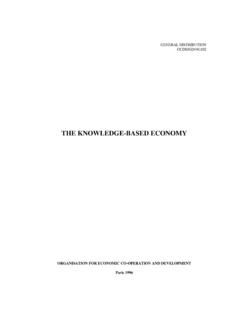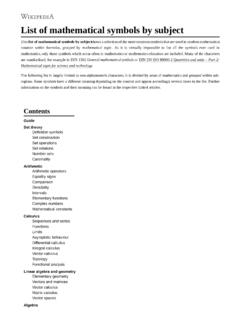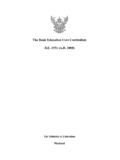Transcription of Golden ratio - Basic Knowledge 101
1 Golden ratioIn mathematics, two quantities are in the Golden ratio if their ratio is the same as theratio of their sum to the larger of the two quantities. The figure on the rightillustrates the geometric relationship. Expressed algebraically, for quantities a and bwith a > b > 0,where the Greek letter phi ( or ) represents the Golden ratio .[1] It is an irrationalnumber with a value of:[2]The Golden ratio is also called the Golden mean or Golden section (Latin: sectioaurea).[3][4][5] Other names include extreme and mean ratio ,[6] medial section,divine proportion, divine section (Latin: sectio divina), Golden proportion, goldencut,[7] and Golden number.[8][9][10]Some twentieth-century artists and architects, including Le Corbusier and Dal , haveproportioned their works to approximate the Golden ratio especially in the form ofthe Golden rectangle, in which the ratio of the longer side to the shorter is the goldenratio believing this proportion to be aesthetically pleasing.
2 The Golden ratioappears in some patterns in nature, including the spiral arrangement of leaves andother plant since Euclid have studied the properties of the Golden ratio ,including its appearance in the dimensions of a regular pentagon and in a goldenrectangle, which may be cut into a square and a smaller rectangle with the sameaspect ratio . The Golden ratio has also been used to analyze the proportions ofnatural objects as well as man-made systems such as financial markets, in somecases based on dubious fits to data.[11]CalculationHistoryTimelineAppli cations and observationsAestheticsArchitecturePainti ngBook designDesignMusicNatureLine segments in the Golden ratioA Golden rectangle (in pink) withlonger side a and shorter side b,when placed adjacent to a squarewith sides of length a, will produce asimilar Golden rectangle with longerside a + b and shorter side a.
3 Thisillustrates the relationship .ContentsList of numbers Irrational and suspectedirrational numbers (3) 2 3 5 S e [2] OptimizationPerceptual studiesMathematicsIrrationalityMinimal polynomialGolden ratio conjugateAlternative formsGeometryRelationship to Fibonacci sequenceSymmetriesOther propertiesDecimal expansionPyramidsMathematical pyramids and trianglesEgyptian pyramidsDisputed observationsSee alsoReferences and footnotesFurther readingExternal linksTwo quantities a and b are said to be in the Golden ratio ifOne method for finding the value of is to start with the left simplifying the fraction and substituting in b/a = 1/ ,Therefore,Multiplying by giveswhich can be rearranged toUsing the quadratic formula, two solutions are obtained:CalculationandBecause is the ratio between positive quantities is necessarily positive.
4 The Golden ratio has been claimed to have held a special fascination for at least 2,400years, although without reliable evidence.[13] According to Mario Livio:Some of the greatest mathematical minds of all ages, from Pythagorasand Euclid in ancient Greece, through the medieval Italianmathematician Leonardo of Pisa and the Renaissance astronomerJohannes Kepler, to present-day scientific figures such as Oxfordphysicist Roger Penrose, have spent endless hours over this simple ratioand its properties. But the fascination with the Golden ratio is notconfined just to mathematicians. Biologists, artists, musicians,historians, architects, psychologists, and even mystics have ponderedand debated the basis of its ubiquity and appeal. In fact, it is probablyfair to say that the Golden ratio has inspired thinkers of all disciplineslike no other number in the history of mathematics.
5 [14]Ancient Greek mathematicians first studied what we now call the Golden ratiobecause of its frequent appearance in geometry. The division of a line into "extremeand mean ratio " (the Golden section) is important in the geometry of regularpentagrams and pentagons. Euclid's Elements (Greek: ) provides the firstknown written definition of what is now called the Golden ratio :A straight line is said to have been cut in extreme and mean ratiowhen, as the whole line is to the greater segment, so is the greater tothe lesser.[15]Euclid explains a construction for cutting (sectioning) a line "in extreme and meanratio" ( , the Golden ratio ).[16] Throughout the Elements, several propositions(theorems in modern terminology) and their proofs employ the Golden ratio .[17]The Golden ratio is explored in Luca Pacioli's book De divina proportione(1509).
6 [10]The first known approximation of the (inverse) Golden ratio by a decimal fraction,stated as "about ", was written in 1597 by Michael Maestlin of theUniversity of T bingen in a letter to his former student Johannes Kepler.[18]HistoryMathematician Mark Barrproposed using the first letter inthe name of Greek sculptorPhidias, phi, to symbolize thegolden ratio . Usually, thelowercase form ( or ) is the uppercase form () is used for the reciprocal of thegolden ratio , 1/ .[12]Michael Maestlin, first to publish adecimal approximation of the goldenratio, in the 20th century, the Golden ratio has been represented by the Greek letter (phi, after Phidias, a sculptor who is said to haveemployed it) or less commonly by (tau, the first letter of the ancient Greek root meaning cut).[3][19]Timeline according to Priya Hemenway:[20]Phidias (490 430 BC) made the Parthenon statues that seem to embody the Golden (427 347 BC), in his Timaeus, describes five possible regular solids (the Platonic solids: the tetrahedron, cube,octahedron, dodecahedron, and icosahedron), some of which are related to the Golden ratio .
7 [21]Euclid (c. 325 c. 265 BC), in his Elements, gave the first recorded definition of the Golden ratio , which he called, astranslated into English, "extreme and mean ratio " (Greek: ).[6]Fibonacci (1170 1250) mentioned the numerical series now named after him in his Liber Abaci; the ratio ofsequential elements of the Fibonacci sequence approaches the Golden ratio Pacioli (1445 1517) defines the Golden ratio as the "divine proportion" in his Divina Maestlin (1550 1631) publishes the first known approximation of the (inverse) Golden ratio as a Kepler (1571 1630) proves that the Golden ratio is the limit of the ratio of consecutive Fibonaccinumbers,[22] and describes the Golden ratio as a "precious jewel": "Geometry has two great treasures: one is theTheorem of Pythagoras, and the other the division of a line into extreme and mean ratio ; the first we may compare toa measure of gold, the second we may name a precious jewel.
8 " These two treasures are combined in the Bonnet (1720 1793) points out that in the spiral phyllotaxis of plants going clockwise and counter-clockwisewere frequently two successive Fibonacci Ohm (1792 1872) is believed to be the first to use the term goldener Schnitt ( Golden section) to describe thisratio, in 1835.[23] douard Lucas (1842 1891) gives the numerical sequence now known as the Fibonacci sequence its present Barr (20th century) suggests the Greek letter phi ( ), the initial letter of Greek sculptor Phidias's name, as asymbol for the Golden ratio .[24]Roger Penrose (b. 1931) discovered in 1974 the Penrose tiling, a pattern that is related to the Golden ratio both inthe ratio of areas of its two rhombic tiles and in their relative frequency within the pattern.[25] This in turn led to newdiscoveries about quasicrystals.[26]De Divina Proportione, a three-volume work by Luca Pacioli, was published in 1509.
9 Pacioli, a Franciscan friar, was known mostlyas a mathematician, but he was also trained and keenly interested in art. De Divina Proportione explored the mathematics of thegolden ratio . Though it is often said that Pacioli advocated the Golden ratio 's application to yield pleasing, harmonious proportions,Livio points out that the interpretation has been traced to an error in 1799, and that Pacioli actually advocated the Vitruvian system ofrational proportions.[3] Pacioli also saw Catholic religious significance in the ratio , which led to his work's title. De DivinaProportione contains illustrations of regular solids by Leonardo da Vinci, Pacioli's longtime friend and collaborator; these are notdirectly linked to the Golden Parthenon's fa ade as well as elements of its fa ade and elsewhere are said by some to be circumscribed by Golden rectangles.
10 [27]Other scholars deny that the Greeks had any aesthetic association with Golden ratio . For example, Midhat J. Gazal says, "It was notuntil Euclid, however, that the Golden ratio 's mathematical properties were studied. In the Elements (308 BC) the Greekmathematician merely regarded that number as an interesting irrational number, in connection with the middle and extreme ratios. Itsoccurrence in regular pentagons and decagons was duly observed, as well as in the dodecahedron (a regular polyhedron whose twelvefaces are regular pentagons). It is indeed exemplary that the great Euclid, contrary to generations of mystics who followed, wouldsoberly treat that number for what it is, without attaching to it other than its factual properties."[28] And Keith Devlin says,TimelineApplications and observationsAestheticsArchitecture"Certa inly, the oft repeated assertion that the Parthenonin Athens is based on the Golden ratio is not supportedby actual measurements.














